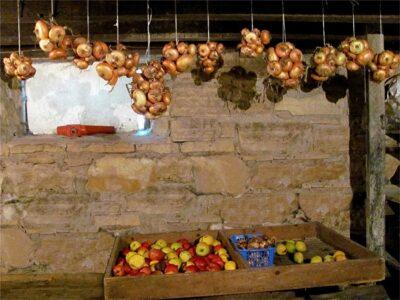|
Listen To The Article
|

A root cellar can have countless practical applications, even in our age of refrigeration.
Although these days you may only see root cellars in horror films, they were once an essential way of life. For our ancestors, a root cellar would have meant the difference between feeding your family and starving to death.
But root cellars have practical applications, even in our age of refrigeration. If the power went out, do you know how your family would preserve fruits and vegetables? Perhaps an icebox? That would require a lot of work to get enough ice to keep everything cool. In addition, chances are that if your fridge doesn’t work, businesses in your vicinity won’t have ice anyway.
Root cellars are the answer. They have been around for hundreds of years as an easy, sustainable way of keeping fruits and vegetables cool and fresh.
What Is A Root Cellar?
A root cellar is a structure built at least partially underground. Also, one can use it to store fruits and vegetables. Root cellars are used to keep food from freezing in the winter and to keep it cool during the summer. Some people also use root cellars to store wine. Generally, vegetables kept in root cellars consist of fall vegetables such as turnips, potatoes, and carrots. Back when root cellars were at their peak, you could often find beer or wine keeping cool among the veggies.
If you have a small home or not enough storage space for your harvest, a root cellar is a great alternative. Even if you aren’t an avid gardener, your root cellar can be used to store your weekly groceries such as water, bread, butter, milk, and cream for short periods of time.
Constructing a cellar is relatively simple and it can be as large or small as you need. Simply put, you just dig a big hole and erect a structure to store your produce. You can build a shed-like structure from scratch. Alternatively, if you don’t need a structure quite that large, you can also use a reclaimed item such as an old refrigerator or an insulated trash can and bury it in the ground. These types of root cellars are popular.
Indoor Root Cellar
If you have enough space in your home, you might want to consider building an indoor root cellar. Ideally, your indoor root cellar or cold room should be in a basement. Preferably, it should also be in the corner so as to take advantage of two cold walls. Frame it out just as you would any other room in the house and put the insulation on the outside of the room.
Keep in mind that while you are building your root cellar indoors or out, you need to have proper ventilation. The warm air will float to the top and needs to vent. Proper ventilation will also keep away unwanted moisture. Otherwise, this precipitation will rot away certain fruits and veggies that are moisture sensitive, like squash. Also, because light can speed up the decomposition of your produce, you’ll want to make sure there is as little light as possible making its way into the root cellar.
Advantages Of A Root Cellar
Basically, you need to dig it out, keep out the sun, and whisk away any unwanted hot air and moisture that could prematurely decompose your veggies. Generally, it is more advantageous to store homegrown fruits and vegetables in your root cellar because they will last a lot longer than the store-bought variety. However, don’t wash your vegetables. The vegetables will have a coating on the outside that keeps them fresher longer.
For pretty much any situation, there is a root cellar for you. It may be an underground shelter with room for all your veggies and your family. Otherwise, it can be a cooler buried in the ground. No matter what kind it is, caring for a root cellar is a skill that will keep your food fresh for a longer time.
You may also enjoy reading an additional Off The Grid News article: Easy DIY Root Cellars (That Don’t Require A Shovel!) [2]
What root cellar tips would you add? Share them in the comments below.
Are You Off-Grid? Then Harness The Power Of Nature’s Most Remarkable Healer: Vinegar [3]